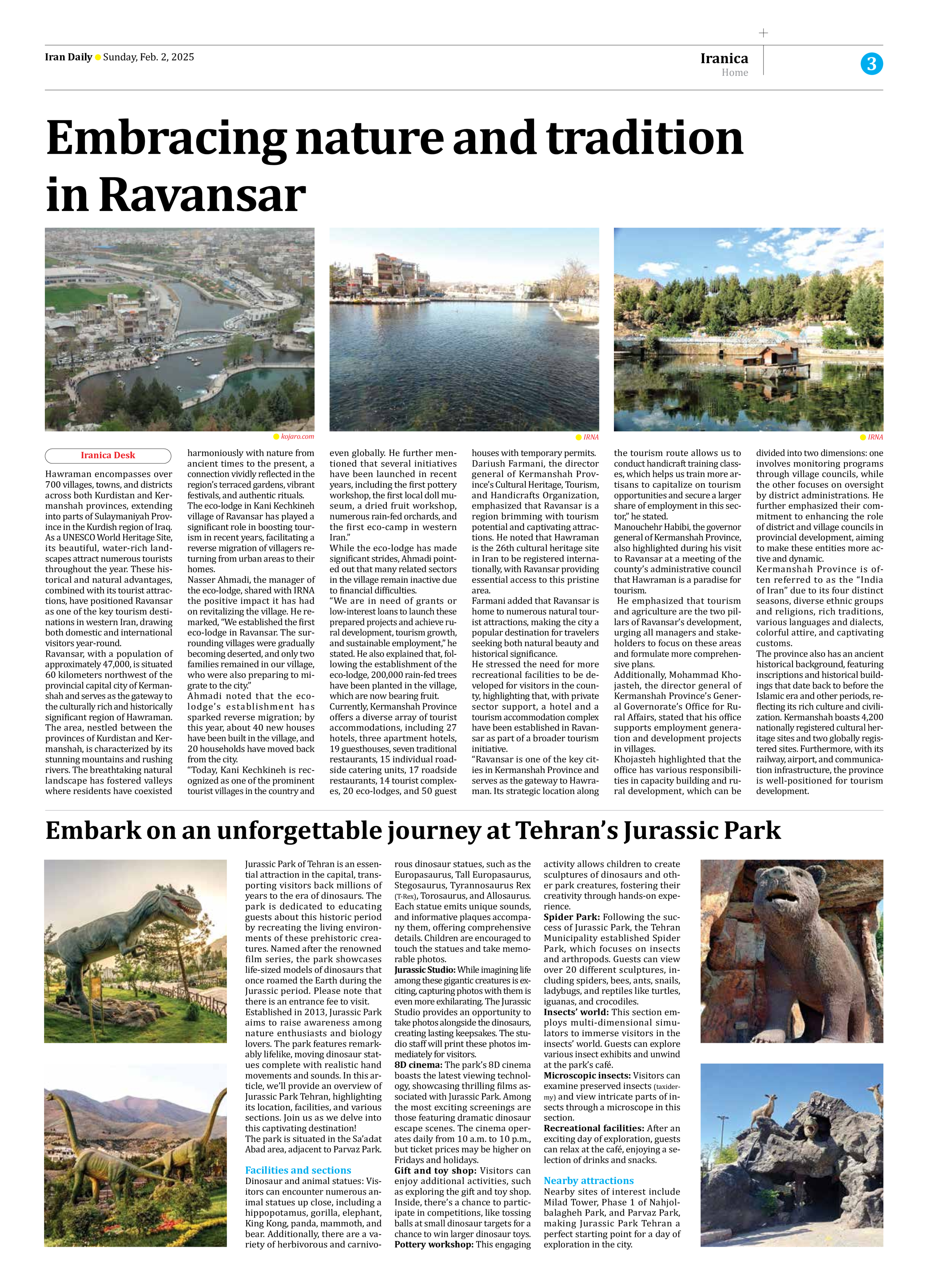
Embracing nature and tradition in Ravansar
Hawraman encompasses over 700 villages, towns, and districts across both Kurdistan and Kermanshah provinces, extending into parts of Sulaymaniyah Province in the Kurdish region of Iraq. As a UNESCO World Heritage Site, its beautiful, water-rich landscapes attract numerous tourists throughout the year. These historical and natural advantages, combined with its tourist attractions, have positioned Ravansar as one of the key tourism destinations in western Iran, drawing both domestic and international visitors year-round.
Ravansar, with a population of approximately 47,000, is situated 60 kilometers northwest of the provincial capital city of Kermanshah and serves as the gateway to the culturally rich and historically significant region of Hawraman. The area, nestled between the provinces of Kurdistan and Kermanshah, is characterized by its stunning mountains and rushing rivers. The breathtaking natural landscape has fostered valleys where residents have coexisted harmoniously with nature from ancient times to the present, a connection vividly reflected in the region’s terraced gardens, vibrant festivals, and authentic rituals.
The eco-lodge in Kani Kechkineh village of Ravansar has played a significant role in boosting tourism in recent years, facilitating a reverse migration of villagers returning from urban areas to their homes.
Nasser Ahmadi, the manager of the eco-lodge, shared with IRNA the positive impact it has had on revitalizing the village. He remarked, “We established the first eco-lodge in Ravansar. The surrounding villages were gradually becoming deserted, and only two families remained in our village, who were also preparing to migrate to the city.”
Ahmadi noted that the eco-lodge’s establishment has sparked reverse migration; by this year, about 40 new houses have been built in the village, and 20 households have moved back from the city.
“Today, Kani Kechkineh is recognized as one of the prominent tourist villages in the country and even globally. He further mentioned that several initiatives have been launched in recent years, including the first pottery workshop, the first local doll museum, a dried fruit workshop, numerous rain-fed orchards, and the first eco-camp in western Iran.”
While the eco-lodge has made significant strides, Ahmadi pointed out that many related sectors in the village remain inactive due to financial difficulties.
“We are in need of grants or low-interest loans to launch these prepared projects and achieve rural development, tourism growth, and sustainable employment,” he stated. He also explained that, following the establishment of the eco-lodge, 200,000 rain-fed trees have been planted in the village, which are now bearing fruit.
Currently, Kermanshah Province offers a diverse array of tourist accommodations, including 27 hotels, three apartment hotels, 19 guesthouses, seven traditional restaurants, 15 individual roadside catering units, 17 roadside restaurants, 14 tourist complexes, 20 eco-lodges, and 50 guest houses with temporary permits.
Dariush Farmani, the director general of Kermanshah Province’s Cultural Heritage, Tourism, and Handicrafts Organization, emphasized that Ravansar is a region brimming with tourism potential and captivating attractions. He noted that Hawraman is the 26th cultural heritage site in Iran to be registered internationally, with Ravansar providing essential access to this pristine area.
Farmani added that Ravansar is home to numerous natural tourist attractions, making the city a popular destination for travelers seeking both natural beauty and historical significance.
He stressed the need for more recreational facilities to be developed for visitors in the county, highlighting that, with private sector support, a hotel and a tourism accommodation complex have been established in Ravansar as part of a broader tourism initiative.
“Ravansar is one of the key cities in Kermanshah Province and serves as the gateway to Hawraman. Its strategic location along the tourism route allows us to conduct handicraft training classes, which helps us train more artisans to capitalize on tourism opportunities and secure a larger share of employment in this sector,” he stated.
Manouchehr Habibi, the governor general of Kermanshah Province, also highlighted during his visit to Ravansar at a meeting of the county’s administrative council that Hawraman is a paradise for tourism.
He emphasized that tourism and agriculture are the two pillars of Ravansar’s development, urging all managers and stakeholders to focus on these areas and formulate more comprehensive plans.
Additionally, Mohammad Khojasteh, the director general of Kermanshah Province’s General Governorate’s Office for Rural Affairs, stated that his office supports employment generation and development projects in villages.
Khojasteh highlighted that the office has various responsibilities in capacity building and rural development, which can be divided into two dimensions: one involves monitoring programs through village councils, while the other focuses on oversight by district administrations. He further emphasized their commitment to enhancing the role of district and village councils in provincial development, aiming to make these entities more active and dynamic.
Kermanshah Province is often referred to as the “India of Iran” due to its four distinct seasons, diverse ethnic groups and religions, rich traditions, various languages and dialects, colorful attire, and captivating customs.
The province also has an ancient historical background, featuring inscriptions and historical buildings that date back to before the Islamic era and other periods, reflecting its rich culture and civilization. Kermanshah boasts 4,200 nationally registered cultural heritage sites and two globally registered sites. Furthermore, with its railway, airport, and communication infrastructure, the province is well-positioned for tourism development.







